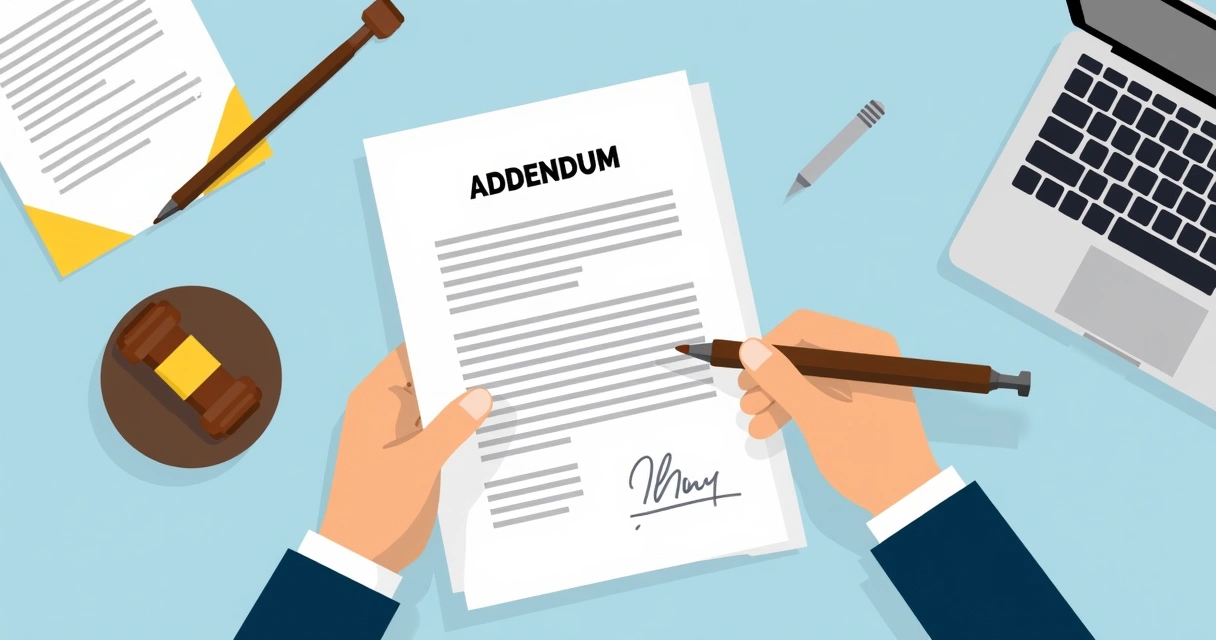Sometimes, changes need to happen. Contracts get old, situations shift, and agreements must adapt. But when a document is already signed, how do you make a tweak without starting from scratch? That’s where the addendum steps in, a way to add, clarify, or adjust a document while keeping the core intact.
What exactly is an addendum?
An addendum, according to Investopedia, is simply an attachment to an already signed contract, used to make changes or add information without rewriting the original. It’s not just a note; it’s a formal, legally binding document, once signed by all parties involved.
A signed addendum carries the same weight as the contract itself.
You might see the term in real estate, insurance, rental agreements, and many other places, anywhere two parties need a record of an agreed change. GeeksforGeeks describes it as a supplement that can modify, nullify, or clarify parts of an agreement. And, most importantly, these documents aren’t valid until everyone involved signs them.

Difference between addendum, annex, appendix, and rider
This is where people often get confused, these terms aren’t the same. Each has a unique role:
- Addendum: Changes, adds, or clarifies terms. It’s a new document attached to the contract, signed by all parties.
- Annex: Additional material that supports, but isn’t part of, the core agreement (think schedules or technical specs).
- Appendix: Supplementary information, charts, examples, references, to help understand the contract.
- Rider: A special kind of add-on, mostly in insurance or entertainment, meant to amend or supplement very specific sections.
They all attach to the original document, but only an addendum directly changes or clarifies that original contract’s terms.
Where are addendums actually used?
The real power of these documents is flexibility. Here’s what I’ve seen (again and again):
- Sales contracts: Suppose you agree to buy a car, but want winter tires included after the contract is signed. An addendum can formally add that term.
- Wills: When someone wants to add a new beneficiary, a codicil (which acts like an addendum) updates the original will.
- Insurance policies: Sometimes coverage needs adjustment. Rather than rewriting the policy, a policy rider clarifies the new scope.
- Real estate deals: Need to extend the closing date? Changing any deadline or price detail? All possible with a quick agreement that makes the change official.
The Cobrief definition of an addendum sums it up: it lets parties agree to changes without losing the structure of the original document.
The key role of signatures
So, why bother signing an addendum? Why not just send an email and call it a day?
Because only signatures make these changes legitimate. A verbal agreement won’t cut it if there’s a dispute in court. Both Corporate Finance Institute and BlueNotary stress that once everyone signs, the changes become legally binding.
Today, electronic signatures, like those offered by CloudSign.ie, make this process smooth and safe, whether you're adjusting a contract in Ireland or beyond. For more on legal aspects of electronic signatures in Ireland, see our guide on electronic signature validity and legal facts.

Why use an addendum instead of a new contract?
I used to think, “why not just rewrite the agreement?” Sometimes that’s the only option, but most of the time:
- It saves time by avoiding renegotiations.
- It helps document exactly what was changed, no confusion.
- It provides a clear history for audits, or if there’s a future dispute.
- It helps maintain control and legal consistency, as the original document stays intact and referenced.
Using an electronic platform like CloudSign.ie means you can create, send, and get addenda signed from anywhere, with a full audit trail. Compare this to traditional processes (and even industry competitors), CloudSign.ie’s integration, security, and ease of use make it a powerful option, well above the crowd.
For those new to digital signatures, check out our beginner’s guide to electronic signatures or our free electronic signature step-by-step guide for practical tips.
Potential pitfalls and challenges
However, there are a few things to watch out for:
- Mutual consent: Each party to the original contract has to agree and sign, unilateral changes won’t hold up.
- Complexity: Sometimes, many addenda pile up, creating a confusing contractual record. Eventually, a new agreement might be clearer.
- Legal and administrative cost: There may be fees for drafting or legal review. I think, in most business settings, that’s worth the risk of a badly drafted agreement.
Above all, when considering formal modifications, consulting a legal professional is a wise move. Laws can vary by country and industry (see electronic signature laws in Ireland 2024).
Oh, an extra tip: avoid making changes informally, even if it feels like you “won’t need it.” That can build misunderstandings or potential for fraud later. If you want more advice on digital contract safety, our tips on document signing mistakes to avoid might help.
Conclusion: make every change matter
Contracts evolve with your business, your family, your life. Addenda let them keep up, quickly, legally, and with far less hassle than rewriting from scratch. But every adjustment should be approached just as seriously as the original contract.
Every change is a new agreement.
CloudSign.ie gives you the tools to make these changes secure, legal, and easy, no matter your business size or needs.
If you want to take control of your documents, keep up with regulations, and get every signature you need (without ever leaving your desk), give CloudSign.ie a try today. See how much simpler and safer contract updates can be.
Frequently asked questions
What is an addendum in a contract?
An addendum in a contract is an attached document that either adds, clarifies, or changes terms in the original agreement without replacing it. It becomes a legally binding part of the contract once all parties sign. This keeps the core agreement intact but allows for flexibility over time.
How do I write an addendum?
To write an addendum: start by referencing the original agreement (include names, date, and relevant section). Clearly state the change, addition, or clarification. List the date the addendum takes effect. Finally, provide signature lines for all parties. Using platforms like CloudSign.ie ensures both efficiency and security throughout the process.
When should an addendum be used?
Use an addendum whenever you need to make a change, clarify a section, or add a term to a contract that’s already signed. Common moments include updating deadlines, adjusting prices, or adding additional conditions, without redoing the full contract.
Are addendums legally binding?
Yes. Once all parties agree to and sign an addendum, it’s legally binding and treated as part of the original contract. Electronic signatures are just as valid as handwritten ones, especially with platforms that provide clear audit trails and verification standards.
Can an addendum change original terms?
Absolutely. That’s the whole point, it can override, add to, or clarify existing terms. But those changes only take effect once everyone involved has signed. If a change is too substantial, though, consider drafting a new agreement for clarity.
